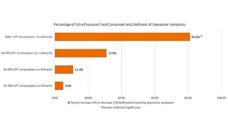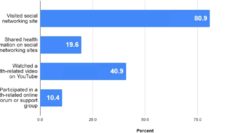The vast majority of food marketing that targets kids promotes fast food, sugary drinks, candy, and unhealthy snacks. Extensive research shows exposure to this marketing increases kids’ preferences for and attitudes toward the products promoted. It also increases how much food kids consume and activates “pester power.” Pester power enlists kids as the mechanism for purchases – encouraging them to beg for advertised products until adults give in.
Viewing YouTube videos is among the most popular online activities for kids ages 6-8, where food marketing reaches them via video and banner advertising. Marketing is also within YouTube videos in the form of branded product placements and influencer endorsements. Influencer marketing, a growing $13.8 billion industry, includes a subset of “child-influencers” who upload videos engaging in child-oriented activities (e.g., play with costumes and props) that sometimes include product promotions. For example, one Ryan’s World (35 million subscribers) video shows Ryan and his dad playing games and eating Lunchables. Ryan and other child-influencers are wildly popular. In the U.S., 27% of 5-to 8-year-olds report subscribing to YouTube celebrities/influencers.
In response to child health experts’ concerns about unhealthy food promotion, YouTube implemented a ban in January 2020 on all food and beverage advertising around videos and channels targeted to children under age 13 (designated as “made-for-kids” videos/channels). However, these bans do not cover product promotions within videos (e.g., product placement or influencer endorsements).
My colleagues and I analyzed videos uploaded in 2019 and 2020 by 13 of the most popular YouTube “made-for-kids” influencers to understand: 1) how often food and beverage brands appeared in videos; 2) what categories (high sugar/salt/fat and healthy) appeared most often; and 3) determine differences between 2019 and 2020. As of June 2020, the total video views for the child-influencer channels in our study exceeded 155 billion. Given the ad ban, we thought influencer food and beverage promotion may have increased in videos posted in 2020.
The high frequency and low-nutrition of the food and beverage brands in child-influencer videos … creates a perfect storm of powerful influence.
We found that food and beverage brands were frequently present and mostly unhealthy. Four out of every ten child-influencer videos contained branded food and/or beverages, mostly candy, sweet and salty snacks, sugary drinks, and ice cream brands, averaging four appearances per video. Just 9% of total appearances were healthy branded products, such as bottled water, plain milk, or fruit. While the total number of food and beverage brand appearances did not change from 2019 to 2020, candy brands increased significantly (36% vs. 47% of total appearances).
We also found that a main character consumed the branded food and/or beverage in approximately one-third of appearances, and in 26% of appearances consumption was suggested (i.e., storyline/handling/preparation suggested the product was consumed). This raises additional concerns as viewers often have “para-social relationships” with influencers, considering them friends and people they would like to imitate. Research has found that children who viewed a character engaging with a brand in a movie were more likely to have positive attitudes toward and choose to consume that brand compared to static product placement.
Further, over 150 food and beverage brands were present in other ways, including verbal mentions by characters, logos on toys, stickers, or in video previews (i.e., thumbnails).
Approximately three video ads were shown during each child-influencer video. Just five ads promoted food or beverage products, indicating adherence with YouTube’s ad ban policy was high, but not complete.
The high frequency and low-nutrition of the food and beverage brands in child-influencer videos coupled with characters happily consuming or engaging with these products creates a perfect storm of powerful influence, with a potential to fuel pester power even better than traditional advertising.
Children are spending increasing amounts of time on YouTube. More effective policies are needed to protect them from the promotion of products that puts their health at risk and takes advantage of their affinity for the children who are showcasing these products: YouTube child-influencers.
Photo via Getty Images














